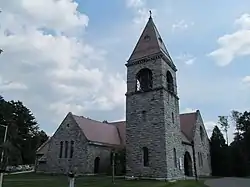Trinity Episcopal Church (Lenox, Massachusetts)
Trinity Episcopal Church is an historic Episcopal church building at 88 Walker Street in Lenox, Massachusetts. Built in 1888 for a congregation organized in 1793, it is a prominent local example of Romanesque architecture, funded by Gilded Age summer congregants. The church was listed on the National Register of Historic Places in 1996.[1]
Trinity Episcopal Church | |
 Trinity Episcopal Church | |
  | |
| Location | 88 Walker St., Lenox, Massachusetts |
|---|---|
| Coordinates | 42°21′16″N 73°16′56″W |
| Area | 1.4 acres (0.57 ha) |
| Built | 1888 |
| Architect | Auchmuty, R.T.; McKim, Mead & White |
| Architectural style | Romanesque |
| Part of | Lenox Village Historic District (ID100006987) |
| NRHP reference No. | 96000363[1] |
| Significant dates | |
| Added to NRHP | April 4, 1996 |
| Designated CP | June 27, 2022 |
History
The first known Episcopalian church services to take place in Lenox were in 1763; it was not until 1793 that a congregation was organized. Its first building, similar to a typical colonial meeting house, was built in 1818, and survives in somewhat altered form as a commercial building on Church Street. The congregation remained small until after the American Civil War, when wealthy residents of large cities began summering in Lenox. The church was enlarged in 1873, but by 1882 it was again judged too small.[2]
Robert Auchmuty, a congregant who had apprenticed with architect James Renwick Jr., headed the committee that oversaw design and construction of the replacement. Auchmuty worked with Charles Follen McKim of McKim, Mead & White to develop plans for the church, and supervised its construction.[2] It was built in 1888 in the Gothic Revival style for the use of a congregation composed in part of the wealthy summer visitors to The Berkshires, who funded its construction. The church was the location of society weddings. For example, on June 6, 1895, James A. Burden Jr., an heir to the Burden Iron Works, wed Florence Adele Sloan, a direct descendant of Cornelius Vanderbilt, in this church.[3]
Notable people
- Robert Shaw Sturgis Whitman, rector
References
- "National Register Information System". National Register of Historic Places. National Park Service. April 15, 2008.
- "NRHP nomination for Trinity Episcopal Church". Commonwealth of Massachusetts. Retrieved February 9, 2018.
- "A Love Match. An American Heiress is Content to Dwell in Her Native Land With an American Male. A Wedding Which Has Cost an Expenditure of a Round Million--A Vanderbilt Gathering". The Wichita Beacon. June 6, 1895. p. 1. Retrieved August 4, 2015 – via Newspapers.com.

